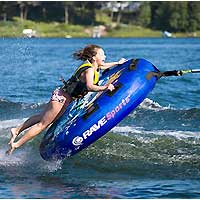Water Towable Ski Tubes
 A towable ski tube is basically an inner tube with handles and a connection for a tow line. The inner tube (sometimes called a bladder) is generally constructed of a strong PVC material. Higher quality tubes feature nylon covers to provide protection for the tube. It really is worth the extra couple of bucks to get a covered tube.
A towable ski tube is basically an inner tube with handles and a connection for a tow line. The inner tube (sometimes called a bladder) is generally constructed of a strong PVC material. Higher quality tubes feature nylon covers to provide protection for the tube. It really is worth the extra couple of bucks to get a covered tube.The ski tube is attached to a nylon ski tube tow rope that will float in the water. Children should be towed with a shorter rope to prevent them from gaining excess speed when moving back and forth across the boat's wake. (Never tow with a rope shorter than 20 feet. This helps to reduce the riders' carbon monoxide exposure from the boat's exhaust.)
This nylon rope is connected to a boat with a water ski towing cleat or harness. To install a tow harness secure two closed hooks to your transom tie-down eyes and the harness will form a "Y" behind your boat. Hook the tow rope to the center of the "Y". Harnesses are also made of nylon. They have a built in float which prevents then from sinking and remain clear of the propeller.
If your boat does not already have a water ski towing cleat you can add one. It is imperative that installation of a towing cleat be in the correct spot on your boat. I suggest contacting the manufacturer of your boat before installation to ensure correct placement.
Types of Ski Tubes
SINGLE RIDER TUBE: Single rider tubes can only hold one rider
 at a time and are usually high performance models. A single rider ski tube is ideal for tricks, jumps, flying, and high speed as they are much more maneuverable. Single rider tubes are perfect for towing behind jet skis. In addition to being more affordable and easier to store, single rider tubes can use standard strength towing lines and harnesses.
at a time and are usually high performance models. A single rider ski tube is ideal for tricks, jumps, flying, and high speed as they are much more maneuverable. Single rider tubes are perfect for towing behind jet skis. In addition to being more affordable and easier to store, single rider tubes can use standard strength towing lines and harnesses.MULTI-RIDER TUBE: Multi-rider ski tubes hold from 2-6 people. Multi-rider ski tube towables are an excellent choice for families or groups of small children. Multi-rider ski tube towables are big, heavy and fairly slow in the water. They should only be used with a heavy duty tow line and harness. Take caution and make sure you adhere to weight limits and stress limitations on all equipment or your tow line might snap and whip the riders, causing serious injury. Multi-rider ski tubes are more expensive and harder to store due to their size.
STANDARD TUBE DESIGN: A standard ski tube is comparable to a large inflatable inner tube. Passengers have a choice of laying across the top of the ski tub on their tummies, sitting in the hole or on top of the tube with their feet in the hole. Standard ski tubes come in both single and multi-rider models.
DECK TUBE: A deck tube is flat and looks like an inflatable mattress. When riding a deck tube towable, you would lie on your stomach and hold on to the handles. This gives the rider a greater perception of speed because their face is forced to be closer to the water. Deck towable tubes offer the best high performance features.
RIDE IN TUBE: A ride in ski tube is much like a raft. Riders sit on a seat or on the floor, with sides surrounding them.
CONCEPT TUBES: Other fun water tube designs include stand-up chariots, inflatable kneeboards, ride-on-top jet skis, hydrofoil boats and multi-rider hot dogs.
For more information on Towable Ski Tube safety, mantainance and other common questoins, visit www.comfortchannel.com and read Ski Tube 101

<< Home